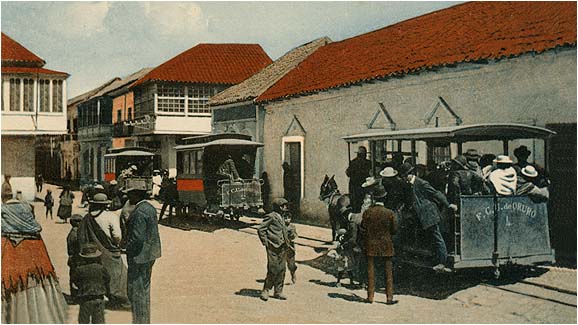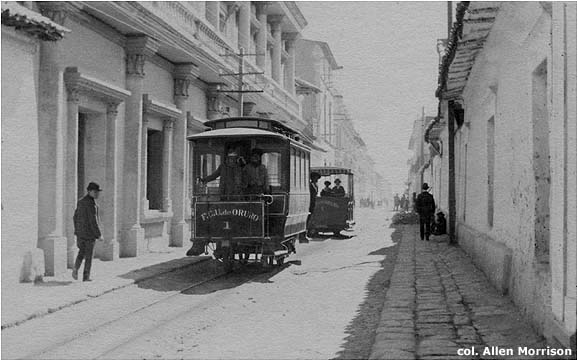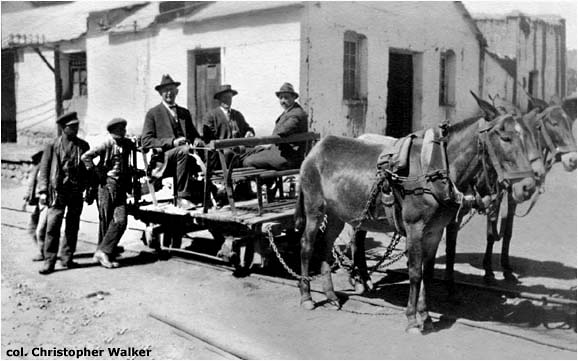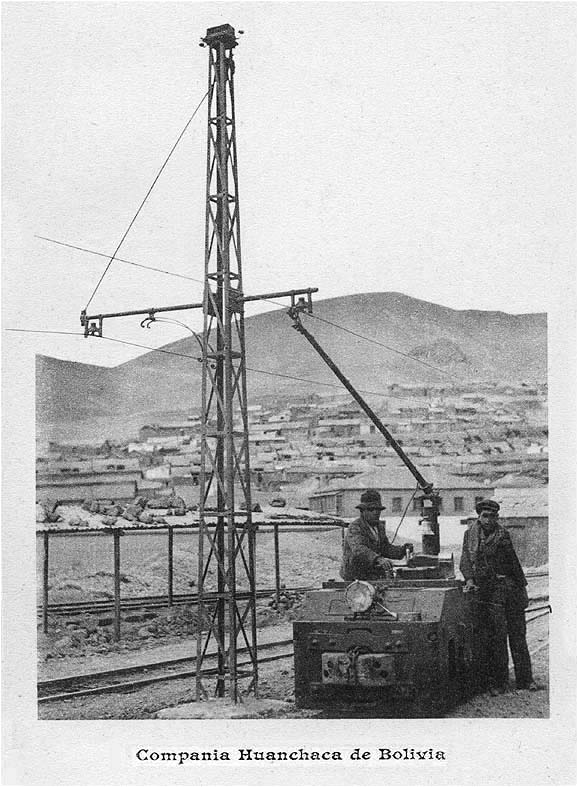The Tramways of
ORURO
and
HUANCHACA
Bolivia
BY
Allen Morrison
ORURO The steam railroad from Antofagasta climbed the Andes and finally reached Oruro, at altitude 3,709 m (12,170 ft), in 1892 [see map]. It did not reach La Paz, 200 km farther north, until 1917. Oruro is one of the principal cities of Bolivia's large mining district. Two Oruro residents, Natalio Condarco and Fabio Espejo, acquired a franchise to build a street railway in 1905 and opened a line on 9 July 1907. Cars ran south on Calle 6 de Octubre to Plaza 10 de Febrero, then west on Calle Murguía. Six months later, on 22 January 1908, the Ferrocarril Urbano de Oruro ordered two trams from J. G. Brill Co. in Philadelphia, which were numbered 1 and 2. (The numbers and origin of the vehicles that opened the system in 1907 are unknown.) FUO ordered another car from Brill in February 1908 and inaugurated a new line to the railroad station later that year. The undated postcard view below shows two Brill trams and an unidentified car, numbered 4, on Calle Bolívar [col. AM]:
The second postcard shows a Brill tram and another car numbered 5. The motive power for both vehicles seems to have run off [col. AM]:
Collisions, derailments and injuries were common, especially at night on the narrow, unlit streets, and the municipal government ordered the system closed. FUO ran its last tram on 30 June 1914, after less than seven years of service.
HUANCHACA The Compañía Huanchaca de Bolivia operates a railroad from Uyuni, near the salt flats in the southwestern part of the country, to Pulacayo and the silver mining district at Huanchaca [see map]. (According to legend, Huanchaca was one of the places where Butch Cassidy and the Sundance Kid robbed a train.) Total length of the line is 43 km and track gauge is 762 mm (30 in). The photo below shows an inspection car at Pacamayo mine in Huanchaca in 1919. Not a tram of the usual sort – but nor is it a train [col. Christopher Walker]:
The mining company also operated electric locomotives. How about this traction pole! [postcard, col. AM]:
BIBLIOGRAPHY Reginald Lloyd. Impresiones de las Repúblicas Sud-Americanas del Oeste en el Siglo XX. London, 1915. This lavish 1,109-page volume contains hundreds of illustrations of every type, including two on p. 395 that show electric wire over tramway track on the streets of Potosí. No tram, just the track – but rare evidence of the existence of an electric tramway in this city. U.S. Bureau of Foreign & Domestic Commerce. Special Agents Series 167: Electrical Goods. Washington, 1918. Several paragraphs on the electric power and tramway installation in Potosí, pp. 14 and 26. Photos of the power plant on p. 15; pictures of a horsecar and an electric tram on p. 28. The source of three illustrations on this webpage. Fabrizio Cazorla Murillo. Los tranvías de Oruro, el transporte de otros tiempos. Unusual, undated online history of the tramways of Oruro, by a journalist at La Patria, the principal newspaper of that city. Superb, rare, valuable information. An email to the author brought no response.
Return to See my index of please e-mail me! Hablo y escribo español.
Copyright © 2005-2105 Allen Morrison - ALL RIGHTS RESERVED |



